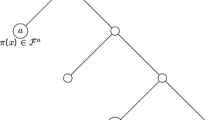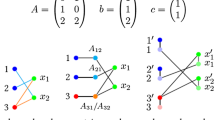Abstract
We introduce orbital branching, an effective branching method for integer programs containing a great deal of symmetry. The method is based on computing groups of variables that are equivalent with respect to the symmetry remaining in the problem after branching, including symmetry that is not present at the root node. These groups of equivalent variables, called orbits, are used to create a valid partitioning of the feasible region that significantly reduces the effects of symmetry while still allowing a flexible branching rule. We also show how to exploit the symmetries present in the problem to fix variables throughout the branch-and-bound tree. Orbital branching can easily be incorporated into standard integer programming software. Through an empirical study on a test suite of symmetric integer programs, the question as to the most effective orbit on which to base the branching decision is investigated. The resulting method is shown to be quite competitive with a similar method known as isomorphism pruning and significantly better than a state-of-the-art commercial solver on symmetric integer programs.
Similar content being viewed by others
References
Achterberg T., Koch T., Martin A.: Branching rules revisited. Oper. Res. Lett. 33, 42–54 (2004)
Barnhart C., Johnson E.L., Nemhauser G.L., Savelsbergh M.W.P., Vance P.H.: Branch and price: column generation for solving huge integer programs. Oper. Res. 46, 316–329 (1998)
Cameron P.J.: Permutation Groups. London Mathematical Society, London (1999)
Dolan E., Moré J.: Benchmarking optimization software with performance profiles. Math. Program. 91, 201–213 (2002)
Foggia, P., Sansone, C., Vento, M.: A preformance comparison of five algorithms for graph isomorphism. In: Proc. 3rd IAPR-TC15 Workshop Graph-Based Representations in Pattern Recognition, pp. 188–199 (2001)
Fulkerson D.R., Nemhauser G.L., Trotter L.E.: Two computationally difficult set covering problems that arise in computing the 1-width of incidence matrices of Steiner triples. Math. Program. Study 2, 72–81 (1973)
Grove L.C., Benson C.T.: Finite Reflection Groups. Springer, Heidelberg (1985)
Hamalainen H., Honkala I., Litsyn S., Östergård P.: Football pools—a game for mathematicians. Am. Math. Monthly 102, 579–588 (1995)
Holm S., Sørensen M.: The optimal graph partitioning problem: solution method based on reducing symmetric nature and combinatorial cuts. OR Spectrum 15, 1–8 (1993)
Kaibel, V., Peinhardt, M., Pfetsch, M.E.: Orbitopal fixing. In: IPCO 2007: The Twelfth Conference on Integer Programming and Combinatorial Optimization, pp. 74–88. Springer, Heidelberg (2007)
Kaibel V., Pfetsch M.E.: Packing and partitioning orbitopes. Math. Program. 114, 1–36 (2008)
Linderoth J.T., Savelsbergh M.W.P.: A computational study of search strategies in mixed integer programming. INFORMS J. Comput. 11, 173–187 (1999)
Litsyn S.: An updated table of the best binary codes known. In: Pless, V.S., Huffman, W.C. (eds) Handbook of Coding Theory volume 1, pp. 463–498. Elsevier, Amsterdam (1998)
Macambira, E.M., Maculan, N., de Souza, C.C.: Reducing symmetry of the SONET ring assignment problem using hierarchical inequalities. Technical Report ES-636/04, Programa de Engenharia de Sistemas e Computação, Universidade Federal do Rio de Janeiro (2004)
Margot F.: Pruning by isomorphism in branch-and-cut. Math. Program. 94, 71–90 (2002)
Margot F.: Exploiting orbits in symmetric ILP. Math. Program. Ser. B 98, 3–21 (2003)
Margot F.: Small covering designs by branch-and-cut. Math. Program. 94, 207–220 (2003)
McKay B.D.: Nauty User’s Guide (Version 1.5). Australian National University, Canberra (2002)
Méndez-Díaz I., Zabala P.: A branch-and-cut algorithm for graph coloring. Discrete Appl. Math. 154(5), 826–847 (2006)
Mills, W.H., Mullin, R.C.: Coverings and packings. In: Contemporary Design Theory: A Collection of Surveys, pp. 371–399. Wiley, New York (1992)
Nemhauser G.L., Savelsbergh M.W.P., Sigismondi G.C.: MINTO, a Mixed INTeger Optimizer. Oper. Res. Lett. 15, 47–58 (1994)
Ostrowski, J., Linderoth, J., Rossi, F., Smriglio, S.: Orbital branching. In: IPCO 2007: The Twelfth Conference on Integer Programming and Combinatorial Optimization. Lecture Notes in Computer Science, vol. 4517, pp. 104–118. Springer, Heidelberg (2007)
Ostrowski, J., Linderoth, J., Rossi, F., Smriglio, S.: Constraint orbital branching. In: Lodi, A., Panconesi, A., Rinaldi, G. (eds.) IPCO 2008: The Thirteenth Conference on Integer Programming and Combinatorial Optimization. Lecture Notes in Computer Science, vol. 5035, pp. 225–239 (2008)
Rotman J.J.: An Introduction to the Theory of Groups, 4th edn. Springer, Heidelberg (1994)
Sewell E.C.: A branch-and-bound algorithm for the stability number of a sparse graph. INFORMS J. Comput. 10, 438–447 (1998)
Sherali H.D., Smith J.C.: Improving zero-one model representations via symmetry considerations. Manage. Sci. 47(10), 1396–1407 (2001)
Author information
Authors and Affiliations
Corresponding author
Rights and permissions
About this article
Cite this article
Ostrowski, J., Linderoth, J., Rossi, F. et al. Orbital branching. Math. Program. 126, 147–178 (2011). https://doi.org/10.1007/s10107-009-0273-x
Received:
Accepted:
Published:
Issue Date:
DOI: https://doi.org/10.1007/s10107-009-0273-x




